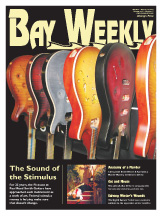Chesapeake Bay's Independent Newspaper ~ Since 1993
1629 Forest Drive, Annapolis, MD 21403 ~ 410-626-9888
Volume xviii, Issue 9 ~ March 4 - March 10, 2010
Home \\ Correspondence \\ from the Editor \\ Submit a Letter \\ Classifieds \\ Contact Us
Best of the Bay \\ Dining Guide \\ Home & Garden Guide \\ Archives \\ Distribution \\ Advertising![]()


Bay Gardener |
Winter’s Ravages
What to do when your evergreens turn yellow
If you are seeing white pine with yellow green needles, don’t worry. It is not uncommon to see some yellowing needles, especially on young trees. This difference is primarily due to the severe cold conditions the trees have experienced thus far this year. This winter the yellowing is the worst I have seen in years.
The same pigments found in the foliage of plants that cause fall foliage colors in deciduous trees and shrubs also exist in the needles of evergreens. During the summer months, carotenoids are not visible because the chlorophyll hides them. The green of the chlorophyll is more intense than the colors of the carotenoids.
A drop of eight to 10 degrees below freezing causes the carotenoids to increase while the amount of chlorophyll remains the same, causing the needles to develop a yellow-green color.
This change in color can be modified — but not until late summer. In mid-August, spray the foliage of the pine trees with a mixture of three tablespoons of Epsom salts, one teaspoon of urea-nitrogen fertilizer and two tablespoons of horticultural oil in a gallon of water. The spray should be applied thoroughly on the foliage in the early morning hours.
The magnesium in the Epsom salt and the nitrogen in the urea will cause an increase in the amount of chlorophyll in the needles, thus minimizing the color change in the fall. Horticultural oil is added to the mixture to allow the foliage to remain wet for a longer period of time to obtain better absorption of the nutrients in the spray.
But don’t let yellow pines worry you now. You’ll have plenty of more pressing jobs after this hard winter. Read the Bay Gardener for recovery advice starting the first week of spring.
Fruits and vegetables you can grow in your garden
Learn how to feed your family from the Bay Gardener in Chesapeake Railway Museum’s Bayside Chat March 7 at 2pm at Northeast Community Center, Chesapeake Beach. Free: 410-257-2554.
Ask Dr. Gouin your questions at [email protected]. All questions will appear in Bay Weekly. Please include your name and address.
© COPYRIGHT 2010 by New Bay Enterprises, Inc. All rights reserved.
